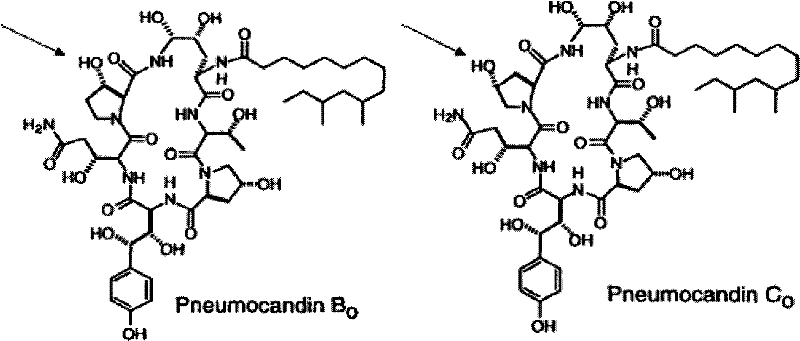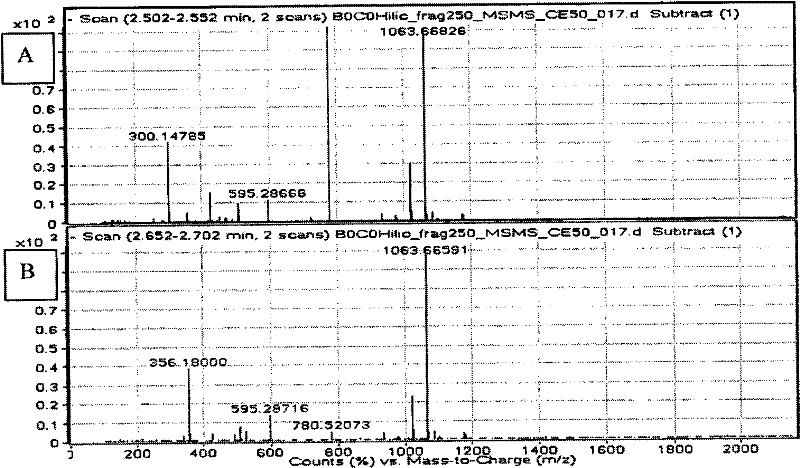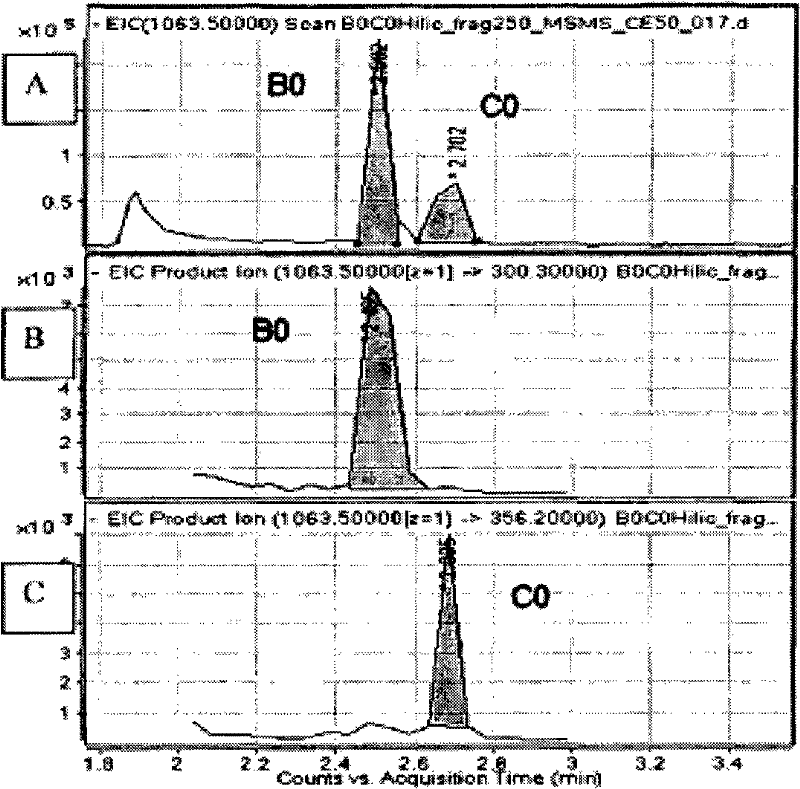Method of detecting pneumocandin compounds
A technology for echinocandin and sample detection, which is applied in the direction of measuring devices, biological testing, material inspection products, etc., can solve the problems of limiting the usefulness of analysis purposes, low stability, and low solubility of echinocandin
- Summary
- Abstract
- Description
- Claims
- Application Information
AI Technical Summary
Problems solved by technology
Method used
Image
Examples
Embodiment I
[0046] In this experiment, an Agilent 1200 HPLC system coupled to an Agilent 6520 quadrupole time-of-flight (Q-TOF) mass spectrometer was used. The Agilent 1200HPLC system is composed of a binary pump, a degasser, a constant temperature autosampler and a constant temperature column chamber (the temperature is set at 25°C). A Supelco Ascentis Express Hydrophilic Interaction Chromatography (HILIC) 15 cm x 4.6 mm, 2.7 micron column was used. The mobile phase consisted of 15% v / v 0.1% w / w ammonium acetate (pH=4.5) and 85% v / v acetonitrile. The flow rate was 1 ml / min. The parameters of the MS ion source are as follows: the nebulizer pressure is 50 psig, the drying gas flow rate is 10 L / min, the drying gas temperature is 350° C., and the capillary outlet voltage is 250 volts. LC-MS / MS analysis was performed in negative ion mode with deprotonation. Separation of echinocandin B at m / z 1063 in quadrupole (Q) 0 or Echinocandin C 0 . The separated pseudomolecular ions were then fra...
Embodiment II
[0054] In this experiment, a Thermo Fisher Surveyor HPLC system coupled to a Thermo Fisher LXQ linear ion trap mass spectrometer was used. The Surveyor HPLC system is composed of a quaternary pump, a degasser, a constant temperature autosampler and a constant temperature column chamber (the temperature is set at 40°C). A Supelco Ascentis Si Hydrophilic Interaction Chromatography 15 cm x 2.1 mm, 5 micron column was used. The mobile phase consisted of 13% v / v 0.1% w / w ammonium acetate (pH=4.5) and 87% v / v acetonitrile. The flow rate was 0.2 ml / min. The parameters of the MS ion source are as follows: sheath gas 35 (arbitrary units), auxiliary gas 15 (arbitrary units), capillary column temperature 350 °C, spray voltage 5 kV, LC-MS / MS in negative ion mode and deprotonation change.
[0055] echinocandin B 0 or Echinocandin C 0 was isolated (at m / z 1063) and fragmented in the ion trap (with a collision energy of 13). The ion trap was set to scan between m / z 290 to 1100 (Figures...
Embodiment III
[0063]In this experiment, an Agilent 1200 HPLC system coupled to an Agilent 6410 triple quadrupole (QQQ) mass spectrometer was used. The Agilent 1200HPLC system is composed of a binary pump, a degasser, a constant temperature autosampler, and a constant temperature column chamber (the temperature is set at 25°C). A Supelco Ascentis Express Hydrophilic Interaction Chromatography 15 cm x 4.6 mm, 2.7 micron column was used. The mobile phase consisted of 15% v / v 0.1% w / w ammonium acetate (pH=4.5) and 85% v / v acetonitrile. The flow rate was 1 ml / min. The parameters of the MS ion source are as follows: the nebulizer pressure is 50 psig, the drying gas flow rate is 10 L / min, the drying gas temperature is 325° C., and the capillary outlet voltage is 4000 volts. LC-MS / MS was performed in negative ion mode and deprotonation was performed. Separation of echinocandin B at m / z 1063 in the first quadrupole (Q) 0 or Echinocandin C 0 . The separated pseudomolecular ions are then fragmen...
PUM
 Login to View More
Login to View More Abstract
Description
Claims
Application Information
 Login to View More
Login to View More - R&D
- Intellectual Property
- Life Sciences
- Materials
- Tech Scout
- Unparalleled Data Quality
- Higher Quality Content
- 60% Fewer Hallucinations
Browse by: Latest US Patents, China's latest patents, Technical Efficacy Thesaurus, Application Domain, Technology Topic, Popular Technical Reports.
© 2025 PatSnap. All rights reserved.Legal|Privacy policy|Modern Slavery Act Transparency Statement|Sitemap|About US| Contact US: help@patsnap.com



